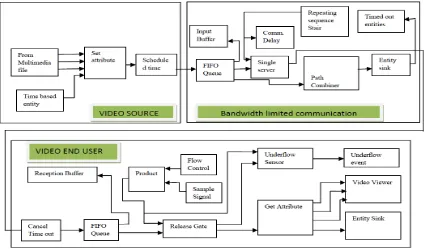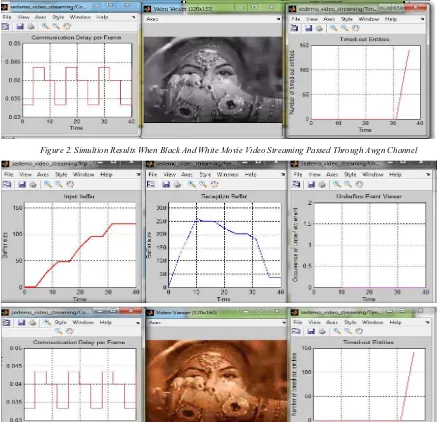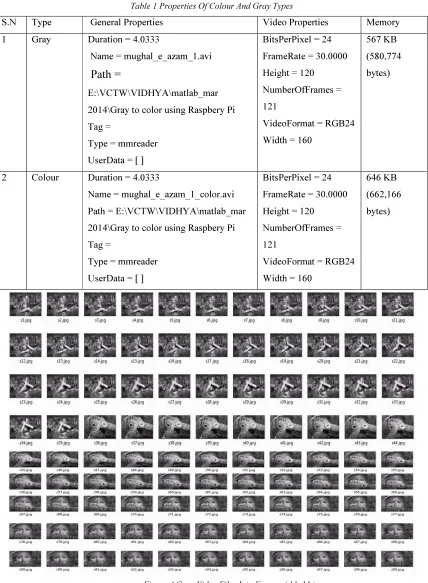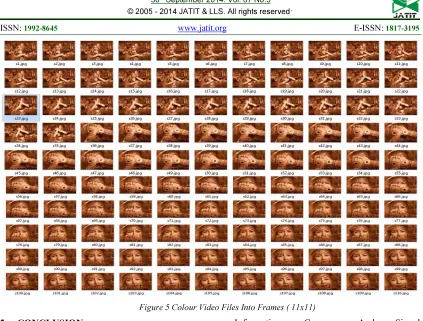CERTAIN INVESTIGATIONS ON VIDEO STREAMING
AND FRAME RATE CLASSIFICATION FOR MULTIMEDIA
APPLICATIONS
1K.VIDYAVATHI, 2R.S.SABEENIAN
1Assistant Professor, Department of ECE, King College of Technology
2Professor, Department of ECE, Centre Head Sona SIPRO, Sona College of Technology
E-mail: vidyavathiece.2010@gmail.com1, sabeenian@gmail.com2
ABSTRACT
One of the fundamental challenges in deploying multimedia systems, such as telemedicine, education, space endeavors, marketing, crisis management, transportation, and military, is to deliver smooth and uninterruptible flow of audio-visual information, anytime and anywhere. A multimedia system may consist of various devices (PCs, laptops, PDAs, smart phones, etc.) interconnected via heterogeneous wire-line and wireless networks. In such systems, multimedia content originally authored and compressed with a certain format may need bit rate adjustment and format conversion in order to allow access by receiving devices with diverse capabilities (display, memory, processing and decoder). Thus, a video coding mechanism is required to make the content adaptive to the capabilities of diverse networks and client devices. In addition, a video coder can change the coding parameters of the compressed video, adjust spatial and temporal resolution, and modify the video content and/or the coding standard used.
This research paper aimed to provide and suggest suitable video coding techniques and some of the related research issues. Also, by this work, it is planned to introduce some of the basic concepts of video coding, then review and contrast various approaches while highlighting critical research issues.
Keywords:HDTV, Temporal Redundancy, AWGN Channel, Frame Split And Matching Algorithm.
1. INTRODUCTION
Generally, the resolution of the TV image is increased for HDTV. In the present HDTV systems only the spatial resolution is increased, without simultaneously increasing the frame rate for improved temporal resolution. This can lead to disappointing results for TV applications, where movement is important. Therefore it is important to consider the motion effects of the HD video signals. The recent LCD panels suffered by the slow response and hold effect, which are the hidden limitations that will degrade the performance of the system. Motion estimation and compensation play key roles in video compression algorithms [3] due to the ability of realizing high compression rates achieved by removing temporal redundancies between successive image frames.
Motion compensation exploits the fact that, often, for many frames of a movie, the only difference between one frame and another is the result of either the camera moving or an object in the frame moving. In reference to a video file, this means much of the information that represents one frame will be the
same as the information used in the next frame. Motion compensation takes advantage of this to provide a way to create frames of a movie from a reference frame. For example, if a movie is shot at 24 frames per second, motion compensation would allow the movie file to store the full information for every fourth frame. The only information stored for the frames in between would be the information needed to transform the previous frame into the next frame.
large communication bandwidth. Therefore this study concentrates on the constant frame rate classification for real time video streaming applications like video conferencing, shooting games etc.,
2. PROBLEM DESCRIPTION
With the onset of the multimedia age and the wide use of Internet, video storage on CD or DVD and streaming video has become highly popular. The digital video application has gained wide appeal in mobile terminals. Examples relating to this are personal digital assistance and cellular phones. The rate of communications with moving video applications is increasing day by day. Now a day video is required in many remote video conferencing systems and for many real time applications, (space application is one of the real time application) also it is expected that in the near future itself the cellular telephone systems will start sending and receiving real time videos.
But a major problem still remains in a video is the high requirement for bandwidth. Yet, due to digital videos inherent data intensity of video sequences, storing and transmitting raw video data becomes impractical. For example a typical system has to send large number of individual frames per second to create an effect or illusion of a moving picture. With the limited storage and bandwidth capacity, this data (raw video data) must be compressed to a transportable size. For this reason, several standards for compression of the video have been developed. Many video compression standards were already in vogue. Digital video coding [4] has gradually become very popular since the 1990s when MPEG-1 first emerged.
3. METHODS AND MATERIALS
The video coding achieves higher data
compression rates and also it eliminates the need of high bandwidth requirements. The important aspect in the video coding is that without any significant loss of subjective picture quality, the video coding [4] achieves higher data compression rates. The ISO Moving Picture Experts Group (MPEG) video coding standards [5] has relevance in compressed video storage on physical media (like CD/DVD). Compared
to the ISO MPEG, the International
Telecommunications Union (ITU) addresses real-time point-to point communications or multi-point communications over a network. The MPEG standard has the advantage of having lesser bandwidth for data transmission.
applications such as CCITT H.261 [11] [7], MPEG-1 [7] and MPEG-2 [7]. One common feature of these standards is that they use Discrete Cosine Transform (DCT), coding to reduce spatial redundancy and block motion estimation [2] [13] or compensation modules to reduce the temporal redundancy. In addition, the encoders complexity of these video standards are dominated by the motion estimation [10]. Currently MPEG-4 [8] has become the dominant video codec algorithm [15] for streaming and distribution of video contents across wireless media at low bandwidth. The latest approved video compression standard, known as MPEG-4 Part 10 AVC or H.264 [9] AVC (AVC - Advance Video
Coding), has shown a 50% compression
improvement when compared to the previous standards. The H.264 or MPEG-4 Part-10 AVC [12] is a block-oriented motion compensation standard. This motion compensated based codec standard and was developed by the combined effort of both ITU-T VCEG and the ISO/IEC MPEG group. The huge improvement over the compression rate makes MPEG-4 Part 10 AVC the best choice of video compression for the next 5-15 years.
By analyzing, it could be understand that, this improvement comes at the cost of increase in computational complexity, which results in higher computation power dissipation. This will be a major drawback for many mobile devices with limited battery life time. Several sources of major computation power dissipation have been identified. One such important cause for this computation power dissipation is Motion Estimation [14]. This paper focuses the transmission of different video schemes
through band limited channels using the
Matlab/Simulink model and its performance
improvement. This work restricted to a band-limited communication channel over which the video signals are transmitted [1] [6]. This work is limited to a video of short duration with off line; but, in real time situation the Unicast/Multicast protocol environment will be considered. Also, a constant bit rate video stream has been taken into account for analysis of this work.
4. RESULTS AND DISCUSSIONS
entire processing requires approximately about 121 frames. Real life video sequence are used to demonstrate the knowledge discovery process i.e., dancer performance with movements from video sequences using the proposed framework. All the videos chosen for this work have same light intensity
and have been taken during day time. The redundant
video frames are removed and hence the video compression has been achieved. Figures 2 and 3 demonstrates the output of the input buffer, reception buffer, underflow event viewer, communication delay frame and timed-out entities for the gray and colored videos respectively. It is clearly shown that there are no differences in the frames transmitted for considering both videos. The estimated parameters and the performances are similar to each other; but suitable video coding/decoding techniques are
essential. Figure 4 and 5 indicates the number of frames per video (11x11) for gray and color videos respectively. The size of the input buffer shows that 120 frames are waiting in the channel. The successive frames will accumulate in the input buffer until they either progress through the channel or time out (up to 32 seconds) for both videos. The size of the reception buffer shows that 252 frames are waiting in the
decoder. The status of underflow events in the
[image:3.595.100.524.330.580.2]decoder has a value of 1.8, whenever the receive buffer permits a frame to advance from the reception buffer to the video viewer, but no frame is present. A periodic communication delay per frame has been occurred between the channel and the input buffer. The number of timed-out entities indicates nearly 155 frames are timed out in the channel for both video streams.
Figure 2. Simultion Results When Black And White Movie Video Streaming Passed Through Awgn Channel
[image:4.595.87.527.259.681.2]Table 1 Properties Of Colour And Gray Types
S.N Type General Properties Video Properties Memory
1 Gray Duration = 4.0333
Name = mughal_e_azam_1.avi
Path =
E:\VCTW\VIDHYA\matlab_mar
2014\Gray to color using Raspbery Pi
Tag =
Type = mmreader
UserData = [ ]
BitsPerPixel = 24
FrameRate = 30.0000
Height = 120
NumberOfFrames =
121
VideoFormat = RGB24
Width = 160
567 KB
(580,774
bytes)
2 Colour Duration = 4.0333
Name = mughal_e_azam_1_color.avi
Path = E:\VCTW\VIDHYA\matlab_mar
2014\Gray to color using Raspbery Pi
Tag =
Type = mmreader
UserData = [ ]
BitsPerPixel = 24
FrameRate = 30.0000
Height = 120
NumberOfFrames =
121
VideoFormat = RGB24
Width = 160
646 KB
(662,166
[image:5.595.86.514.126.709.2]bytes)
Figure 5 Colour Video Files Into Frames ( 11x11)
5. CONCLUSION
In this paper a study on motion estimation and transmission of gray and colored video streaming over a band-limited AWGN channel has been considered. As the motion estimation has various promises in applications like video telephony, HDTV, automatic video tracker and computer vision etc. in handheld devices. Thus, extensive research has been done over years to develop new video coding
algorithms and designing cost-effective and
massively parallel hardware architecture suitable for current VLSI technology. So, till now there is unlimited number of algorithms being claimed by different researchers in world. From all the previous types of algorithms discussed, the frame split and matching algorithms are the simplest way for motion estimation in terms of hardware and software implementations. The contribution towards the motion estimation and improvement in image quality and compression rates are visible in this approach.
REFERENCES:
[1] J.Feng, K.-T. Lo, H. Mehrpour, and A. E. Karbowiak, “Adaptive block matching motion
estimation algorithm using bit plane
matching,” in Proc. ICIP’95, 1995, pp. 496– 499.
[2] S.Zhu and K.K.Ma, “A new diamond search
Information, Commn. And Signal
Processing(ICICS). Vol.1, pp.292- 296, Sept9-12 1997
[3] Borko Furht, Joshua Greenberg, Raymond Westwater, Motion Estimation Algorithms For Video Compression. Massachusetts: Kluwer Academic Publishers, 1997. Ch. 2 & 3. [4] M. Ghanbari, Video Coding, An Introduction
to Standard Codecs, London: The Institute of Electrical Engineers, 1999. Ch.2, 5, 6, 7 & 8 [5] P. Kauff , K. Schüür, "Fast Motion Estimation
for Real- Time Shape-Adaptive MPEG-4 Video Encoding", International Multimedia Conference Proceedings of the 2000 ACM workshops on Multimedia Los Angeles, California, United States Pages: 55-58 ;2000. [6] Shan Zhu, and Kai-Kuang Ma, “ A New
Diamond Search Algorithm for Fast Block-Matching Motion Estimation”, IEEE Trans. Image Processing, vol 9, no. 2, pp. 287-290, February 2000.
[7] E.Iain G. Richardson, "H.264 and MPEG-4 Video Compression", John Wiley & Sons, September 2003, ISBN 0-470-84837-5. [8] Y. Donghoon , J. Sung Kyu, R. Jong Beom,
"Fast motion estimation for shape coding in MPEG-4",. IEEE Trans. Circuits Syst. Video Techn. Vol 13 (4): 358-363 (2003).
H.264/AVC,”in Proc. IEEE Int. Conf. Acoust., Speech Signal Process. (ICASSP),vol.5.May 2004, pp. 9–12.
[10] A. Ertürk and S. Ertürk, “Two-bit transform for binary block motion estimation,” IEEE Trans. Circuits Syst. Video Technol., vol. 15, no. 7, pp. 938–946, Jul. 2005.
[11] C. Chen, Ping-Hao Wu and Homer Chen,
“Transform-Domain Intra Prediction for
H.264,” IEEE ISCAS, pp. 1497-1500, May 2005.
[12] C.Yang, S. Goto, and T. Ikenaga, “High performance VLSI architecture of fractional motion estimation in H.264 for HDTV,” in Proc. IEEE Int. Symp. Circuit Syst. (ISCAS), May 2006, pp. 2605–2608.
[13] Trans. Circuits Syst. Video Technol., vol. 7, no. 4, pp. 702–706, Aug. 1997. S. Ertürk, “Multiplication-free one-bit transform for low-complexity block-based motion estimation,” IEEE Signal Process. Lett., vol. 14, no. 2, pp. 109–112, Feb. 2007.
[14] P. Vijaykumar, Aman Kumar, Sidharth Bhatia” Latest Trends, Applications and Innovations in Motion Estimation Research”
International Journal of Scientific &
Engineering Research Volume 2, Issue 7, July 2011 ISSN 2229-5518



